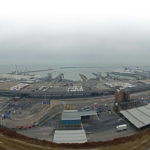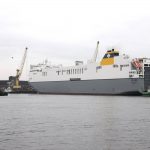The spectre of post-Brexit customs delays causing congestion at major RoRo port Dover, coupled with a shortage of haulage drivers and the ongoing effects of Felixstowe’s troublesome new IT system, all suggest the pattern of UK short sea trades may be due for a shake-up
Dover itself awaits the final withdrawal agreement to see how »frictionless« or otherwise future trade with the EU will prove[ds_preview], but is already staunchly defending its position. The port is currently Europe’s busiest RoRo port, handling up to 17% of the UK’s trade worth £122 bn on 2.6mill. freight vehicles p.a., as well as 2.4mill. tourist vehicles and 12mill. passengers. Dover has released figures suggesting that if just 20% of its traffic flow was diverted to other UK ports, it would cost a massive £2.5 bn – that figure consisting of the additional freight cost of longer sailings, extra time and cost of less direct routing and the capital cost of more ships needed. Also, the port is embarking on a Dover Western Docks Revival scheme, co-financed by the EU, under which all LoLo traffic would be moved to a new berth to be built there, freeing up more space at the Eastern Docks for future growth in RoRo operations.
However, other UK ports are laying their own plans to attract more short sea traffic from EU ports.
London’s Port of Tilbury has launched a £1 bn investment programme that will see the building of an entire new second terminal on a nearby piece of land that has become available. Green light to begin construction is hoped for in Q1 2019. Largest component of the new multi-use terminal will be a RoRo area with container and trailer parking space plus warehousing.
Fastest growing trade at the port is P&O Ferries’ Tilbury-Zeebrugge route for unaccompanied trailers, and Tilbury makes no secret of hoping this traffic will increase post-Brexit as shippers seek to avoid Dover-Calais
Tilbury’s London Container Terminal (LCT) already handles around 500,000 containers a year, mostly from European short sea services now that nearby DP World London Gateway receives deep-sea lines, making it the UK’s third busiest box facility behind Felixstowe and Southampton.
A few miles away, Hutchison Ports’ London Thamesport has just secured a second weekly service from Gdynia by Helsinki-based Containerships, which according to the port’s director Mark Taylor »reflects the growing interest we are seeing for short sea container services into London.«
»As Brexit draws nearer,« he says, »an increasing number of importers and exporters are reviewing their supply chain strategies, looking for routes that offer high resilience whatever the Brexit outcome.«
The adjacent London Medway cluster of small ports, including Sheerness and Chatham, has published a document outlining an alternative post-Brexit supply chain strategy for container imports/export »using uncongested ports« – like Medway – with available space for stand trailers where boxes can be stored until sailings or haulage drivers are available.
Further afield, the ports of Liverpool in northwest England and Newcastle, Teesport and Hull in the northeast have formed a four-way Northern Ports Alliance (NPA) that is seeking to achieve a »re-balancing« of UK container flows. Currently around 90% of the UK’s seaborne container trade enters or leaves via southern ports, they point out, although 60% is actually heading to or from the West Midlands or further north, with the extra road and rail transport involved causing unnecessary congestion and diesel emissions.
The NPA wants to change this and would like to see the setting up of a »northern rail corridor« for box traffic between the two coasts.
Liverpool already secured the temporary diversion of some calls by Maersk and MSC on their 2M transatlantic services to its new Liverpool2 deepwater terminal during the height of the disruption caused by Felixstowe’s installation of its new Terminal Operating System in the summer, and owner Peel Ports is now actively seeking more direct short sea links with Ireland and continental Europe via its feeder subsidiary BG Lines (see also separate story).
Port of Hull, owned by ABP, added an important new container service at its Hull Container Terminal in October when Samskip began a twice-weekly service to Antwerp using a 500 TEU vessel, while Humber ports in general – also including Immingham – registered a 9% increase in container traffic overall last year.
»With the current Brexit uncertainty, we believe that our spread of dedicated short sea services can offer robust options for companies wanting to de-risk their supply chain in preparing for Brexit,« said Samskip UK & Ireland Regional Director, Richard Beales.
Teesport belonging to PD Ports has begun receiving new Unifeeder direct routes to and from Antwerp and Dunkerque, as well as enhanced intermodal links to Scotland with addition of a second daily rail service.
»Short sea services are the lifeblood of our ports and this partnership with Unifeeder offers more routes in and out of Europe and into the UK,« comments PD Ports general manager Kim Catterick.
Teesport’s improved rail links to Scotland follow DFDS’s decision to terminate its Rosyth-Zeebrugge service last April. P&O Ferries responded by increasing freight capacity by 25% on its Zeebrugge-Teesport sailings, which now interconnect with the improved Scottish rail service.
Rising truck traffic between eastern Europe and the UK has been boosting P&O’s freight-only Zeebrugge-Teesport service, which also picked up some cargoes diverted from French channel ports because of industrial action and illegal migrant activity there in recent years, and could do so again in the event of post-Brexit border delays.
»Customers want direct access and guaranteed schedules,« says PD Ports’ Catterick, which has led to »an increasing demand to move away from the congestion at some of the major European and UK ports.«





















